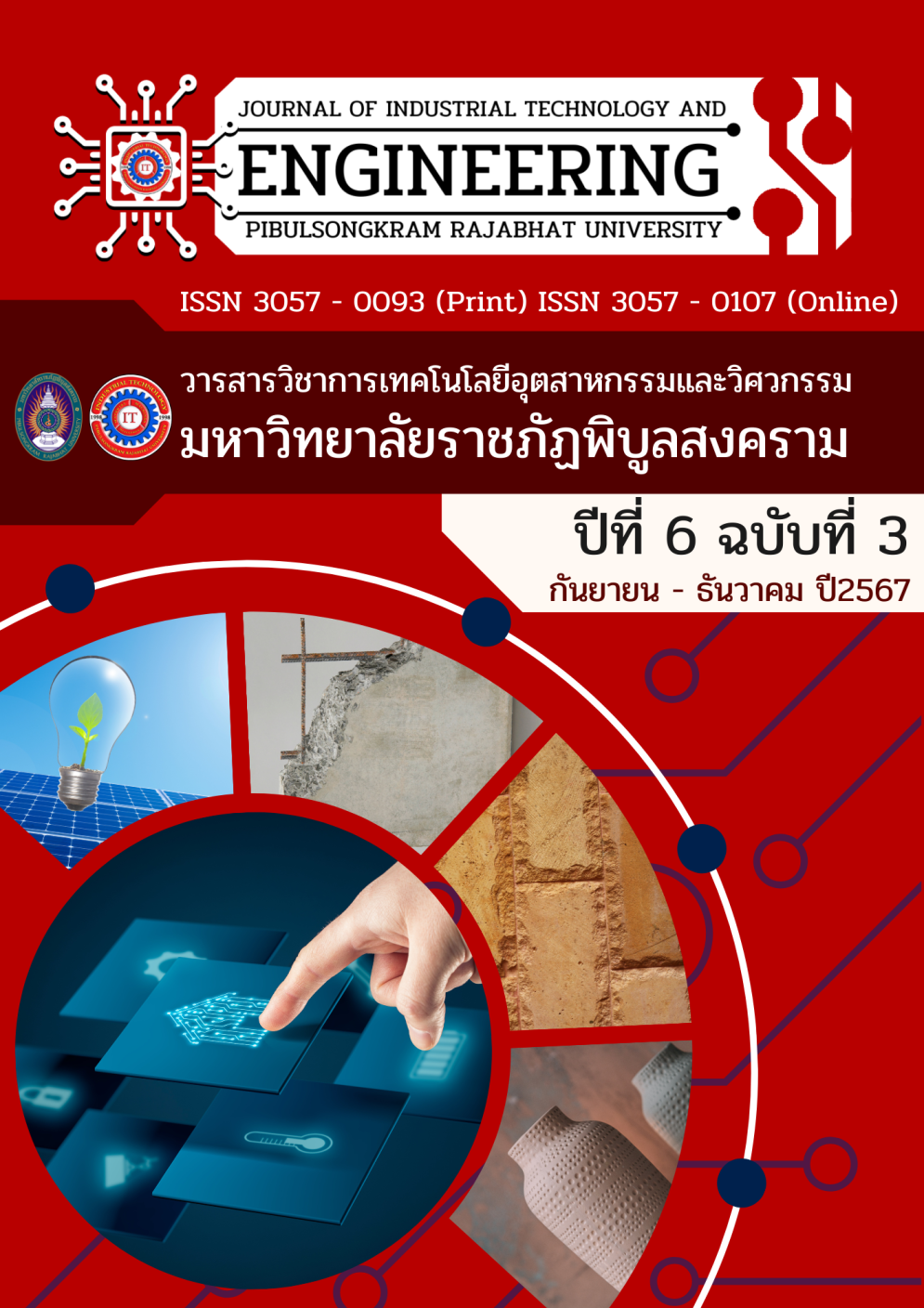EFFECTS OF MANGANESE DIOXIDE, NICKEL OXIDE, AND COPPER OXIDE ON COLOR APPEARANCE OF FELDSPAR GLAZE AT 1230 ๐C
Keywords:
Feldspar glaze, Manganese dioxide, Nickel oxide, Copper oxideAbstract
This research aims to: 1) study the amounts of manganese dioxide, nickel oxide, and copper oxide that affect the color appearance of feldspar glaze, and 2) study the amounts of manganese dioxide, nickel oxide, and copper oxide that affect the surface characteristics of the feldspar glaze. To conduct the study, base glazes with specific compositions of manganese dioxide, nickel oxide, and copper oxide were prepared according to a ternary diagram, resulting in 15 different formulations. These formulations were processed by weighing and grinding at high speed for 5 minutes, followed by firing at 1230°C in an oxidation atmosphere. The analysis of color development, brightness, and color values of the glazes was conducted using a colorimeter. The findings revealed six color groups: 1) RAL-LS 7043, 2) RAL-LS 7024, 3) RAL-LS 7009, 4) RAL-LS 7010, 5) RAL-LS 7013, and 6) RAL-LS 7003. The brightness and color values of the glazes were as follows: L* values ranged from 25.05 to 37.33, a* values ranged from -0.65 to 0.54, and b* values ranged from -2.26 to 6.58. Two surface characteristics were observed: 1) semi-matte surfaces in formulations 7, 11, and 12, and 2) glossy surfaces in formulations 1, 2, 3, 4, 5, 6, 8, 9, 10, 13, 14, and 15, with gloss levels ranging from 30 to 85 GU. Additionally, formulations 4, 7, 8, and 11 exhibited a coating surface resembling the texture of an orange peel. The compositions, which can be applied in ceramic art and glaze development for industrial applications, include: 45% feldspar, 10% dolomite, 13% calcium carbonate, 7% kaolin, and 25% quartz. Oxides that can be used are: 1) manganese dioxide (2–6%), 2) nickel oxide (2–3%), and 3) copper oxide (2–6%).
References
ดรุณี วัฒนศิริเวช, และสุธี วัฒนศิริเวช. (2552). การวิเคราะห์แร่ดินเคลือบและตำหนิในผลิตภัณฑ์
เซรามิก. กรุงเทพฯ: จุฬาลงกรณ์มหาวิทยาลัย.
ธมลวัฒน์ หิรัญชาติอนันต์. (2565). การพัฒนาสูตรเคลือบดอกซากุระโดยใช้นิเกิลออกไซด์เป็น
สารให้สี. วารสารวิทยาศาสตร์และเทคโนโลยี มหาวิทยาลัยราชภัฏศรีสะเกษ, 2(2), 23-31.
สืบค้นจาก https://li01.tci-thaijo.org/index.php/STJS/article/view/254466
ปราโมทย์ ปิ่นสกุล. (2552). การทำน้ำเคลือบเซรามิกส์จากเศษผงปูนปลาสเตอร์. วารสารวิจัยและ
พัฒนา มหาวิทยาลัยราชภัฏบุรีรัมย์, 4(1), 63-71.
พรชัย ปานทุ่ง. (2558). การพัฒนาน้ำเคลือบเซรามิกส์จากเนื้อดินพื้นบ้าน. วารสารวิจัยสหวิทยาการ
ไทย, 10(3), 38-44. สืบค้นจาก https://ph02.tci-thaijo.org/index.php/jtir/
article/view/45040
ไพจิตร อิ่งศิริวัฒน์. (2546). สีเซรามิกส์. กรุงเทพฯ: โอเดียนสโตร์.
ไพจิตร อิ่งศิริวัฒน์. (2547). รวมสูตรเคลือบเซรามิกส์ (พิมพ์ครั้งที่ 2). กรุงเทพฯ: โอเดียนสโตร์.
ไพจิตร อิ่งศิริวัฒน์. (2552). ตำหนิเซรามิกและแนวทางแก้ไข. กรุงเทพฯ: โอเดียนสโตร์.
ภรดี พันธุภากร, และเสกสรรค์ ตันยาภิรมย์. (2542). เคลือบเซรามิกส์จากเปลือกหอยนางรม.
(รายงานการวิจัย). ชลบุรี: มหาวิทยาลัยบูรพา.
ศิริมา เอมวงษ์. (2557). การพัฒนาเคลือบโครมทินเรด อุณหภูมิ 1200 องศาเซลเซียส.
วารสารวิชาการคณะเทคโนโลยีอุตสาหกรรม มหาวิทยาลัยราชภัฏลำปาง, 7(1), 52-57.
สืบค้นจาก https://li01.tci-thaijo.org/index.php/Itech/issue/view/3207
สุขุมาล สาระเกษตริน. (2564). เครื่องปั้นดินเผาการออกแบบและปฏิบัติงาน. กรุงเทพฯ: 50 Press
Printing.
สำนักงานมาตรฐานผลิตภัณฑ์อุตสาหกรรม. (2556). เครื่องปั้นดินเผาสโตนแวร์ (มผช. 930/2556).
สำนักงานมาตรฐานผลิตภัณฑ์อุตสาหกรรม.
Singer S.S. (1963). Industrial ceramics. London: Chapman and Hall Ltd.



